 Chapter 1: Engagement Activities and Tips for Practitioners
Chapter 1: Engagement Activities and Tips for PractitionersThe participation of young people, in any context, matters so much that it is written into the UN Convention on the Rights of the Child:
“Children have the right to give their opinions freely on issues that affect them. Adults should listen and take children seriously”
Article 12: The United Nations Convention on the Rights of the Child (UNCRC – Child friendly version)
Young people responding to the 2021/22 HSCP children and young people survey certainly agreed. They said…
‘Allow more work/activities/opportunities to express opinions, beliefs and interests because otherwise students will be disengaged and this often leads to a decline in mental health and therefore that creates a bad relationship with the young person’
‘Keep listening. Even if you don’t like what we’re saying, just keep listening’
Arguably, when the decisions being made directly affect a child’s life, such as with safeguarding, it matters even more. However, the process of engaging with young people in a meaningful and inclusive way is not always easy – especially when some young people are already distrustful or disillusioned with the process.
‘It just feels like tokenism…’
…is a phrase that many young people respond with when faced with the suggestion of a survey, for example. It makes absolute sense; if something is not worthwhile, why would any of us want to do it?
For participation to work, initial engagement needs to include the purpose and managing expectations. Young people need to know what they are being asked to contribute to and how their responses will be used, without over-promising. Once this is clear, and you have ‘buy in,’ the results are incredibly rewarding.
Any form of participation, and engagement in it, relies on communication skills: dialogue, language and tone. Getting it right has the power to capture attention, garner trust and empower young people. It offers the opportunity to show care and apportion worth. Where the tone, dialogue and language are misjudged, however, there is the potential to very quickly alienate a young person.
Some of the views shared in the HSCP children and young people survey emphasised this:
‘Your facial expressions and body language when you’re listening makes a MASSIVE difference on how supported someone feels!’
‘Though we can feel listened to and safe, we don’t always feel cared for’
Leicester City and Leicestershire and Rutland Safeguarding Children Partnership put it really well in the short video
Was Not Heard was conceived by five groups of young people. A script was then developed from their ideas and written by a young person. This was then made into a film with the support of Leicester City Participation Service and Badshoes Film and performed by young actors. It was funded by NHS England and LLRSC. Fuller interviews are also available on their YouTube channel.
It doesn’t take a lot to get it right! Imagine the difference that Response B would make, as compared to Response A…
A young person has been struggling with their mental health for some time. They sort of know the reason for it, but hasn’t told anyone, and doesn’t know how to control the feelings they’re having. They pluck up the courage to ring a local agency helpline. After trying to explain this to the person on the end of the line, they get this response…
“Right (SIGH) Have you got a referral? No? Well you need a referral from your GP. Well there’s a lot of young people like you at the moment, so we’ve got a waiting list. It’s about 7 months. Try your GP and then get back to us. OK? Thanks.”
“Sorry to hear you’re feeling like that. I have to ask; do you feel like you’re in any immediate danger of hurting yourself or someone else? No, great. Have you got a referral from your GP at all? No, don’t worry. A referral’s a really good starting point as we’ve got a waiting list of about 7 months at the moment and your GP can help get you onto that if they think it’s the right thing for you. I know it’s a long time, but there’s lots of other support out there in the meantime too. If you go on our website there are links for helpful resources and if you need to talk to anyone at any time there are also links to the Samaritans and Child-Line. OK? You’ve done the right thing calling. Give your GP a bell and we’ll get the ball rolling. Take care”
It may seem extreme, but the first example comes directly from a young person’s experience. The second response says pretty much the same thing as the first, but a more considered tone and dialogue means that the young person feels different having finished the phone call. The organisation has also identified signposting resources that can help. They feel supported, valued and cared for. They also feel like there was a point to ringing.
What We Need was created by a group of young people at No Wrong Door in Hereford, following focus groups on the topic of use of ‘tone’?
As with any form of engagement with young people, participation is far easier if there are trusting and honest relationships, which help put people at ease and support contributions. Sometimes we don’t have much time to build these relationships.
There are many tried and tested techniques that help the discussion get off to a good start, and having an arsenal of these to hand is always useful – especially as young people are clear that one size does not fit all:
‘Understand that every young person is different and have been through different experiences with life that will need different approaches to help support them’
‘You should not press people, give them time to express how they feel in their own way because for some people it is harder than others’
Particularly useful links to explore ideas are:
This link has 40+ examples of visual tools taken from Barnados ‘Say it your own way’ booklet. The Social Worker Toolbox also has resources on all aspects of talking to young people and though the resources are specific to social work assessment, they are useful for other professionals too.
For a really accessible resource, with lots of original ideas as well as some of the old favourites, the Children and Young People’s Health Service Norfolk and Waveney website is fantastic. It’s particularly useful to engage younger children.
With so many options to choose from, the general rules are simple:
‘Make sure you know that we are all different and have different needs’
An initial question of ‘which emoji are you at the moment and why?’ can prompt a whole disc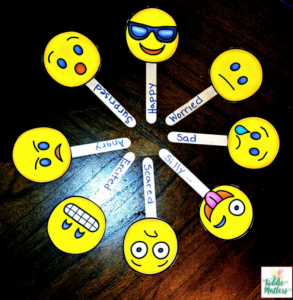 ussion very easily.
ussion very easily.
If a young person is particularly unwilling to contribute their own views, why not pair the emoji with images of another young person/celebrity and ask which emoji the young person thinks that person is and why. It can then lead to further discussions about what might be needed to change the emotion.
Image from resources website KIDDIEMATTERS.COM
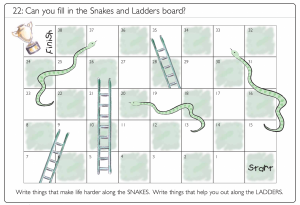 Games always go down well with young people (age appropriate).
Games always go down well with young people (age appropriate).
This Snakes and Ladder game asks them to focus on things that make life easier for them and things that make it harder – of course the focus could be changed to fit any participation question.
Snakes and Ladders image from ‘SAY IT YOUR OWN WAY’ (BARNARDOS)
With older young people conversation starters (daft or serious) can put them at ease and bring a little light-heartedness to the conversation. Showing you respect their responses will bode well for later m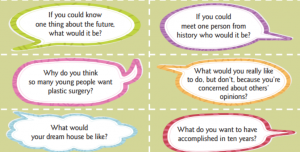 ore potentially difficult discussions.
ore potentially difficult discussions.
From Parenting Website IMOM.COM
The Signs of Safety approach is ‘a relationship-grounded, safety-organised approach to child protection practice.’ Herefordshire has adopted Signs of Safety as its overarching practice model for working with children and young people in Herefordshire.
There are plenty of well-researched and designed resources for direct work in Signs of Safety, including My Three Houses, The Fairy or Wizard, and Words and Pictures.
Visit our Signs of Safety page for more information, resources and tools
‘I see a counsellor, and my time could be improved loads if we played games or did activities together’
Inclusivity and accessibility is always key to participation. Children and young people of different abilities or with different backgrounds will communicate and react differently. Full representation can inform the development of service provision far better than the views of a small number. This was identified as being a top priority amongst young people surveyed:
‘We’d like to be listened to and taken seriously irrelevant of ethnicity, gender identity, ability, disadvantage and other barriers’
‘Try and see things from their point of view, take into account that they experience, deal and cope with things in different ways than you can expect’
These are ideas on how your preparation could help, whether approaching a wide-ranging group or special interest groups:
Identify the barriers to participation for any young person – for example, is it money/access/fear of prejudice/age?
Accommodate different literacy levels and work in the language of participants – how you phrase questions is particularly important.
Ensure all the information is accessible to everyone – if this is online, think about access/lack of it to the internet, but also capability for screen reader functions, larger fonts, or how it displays on a phone screen.
Ask venues about their accessibility so you can choose appropriate venues.
Provide practical resources like transport, crèche facilities, translation, signing.
Approach excluded children and young people directly and through their communities.
Involve excluded children and young people in contacting others, in person or through the design of information and strategies for making contact.
Use a variety of methods of consultation.
Ensure group ground rules cover equality of opportunity issues and that these are implemented.
Develop facilitating skills to enable those who are less confident and marginalised to participate fully in group.
Meet regularly to build skills and confidence of consulted children and young people
Adapted from ‘BREATHING FIRE INTO PARTICIPATION’ – Aspinwall and Larkins and Welsh Assembly Government (2002)
“To fully listen to children, we need more than just our ears – we need our eyes, our touch, and an ability to put ourselves in the children’s shoes, to think about things from their point of view” – Penny Webb (Early Years Expert)
Babies and younger children have different ways of expressing themselves, but that doesn’t mean that practitioners are not able to capture their “voices.” Practitioners must recognise that these children have different ‘voices,’ and that non-verbal communication is as important as verbal communication. Focus on the child’s lived experiences, and use observation to understand the child’s world. Gathering the voices of babies and young children needs to be multi-dimensional and not using only one source or perspective.
The Leuven scale of emotional well-being is a great practical tool because it puts a child’s emotional well-being first and foremost. It has two parts and is a way of observing a child’s well-being and involvement in their surroundings. A child with low well-being is far more likely to exhibit extreme behaviour and not engage with opportunities available to them. See resources below for more information about the Leuven Scale and how to use it.
Observe a child in different settings/places – How do they interact with their surroundings? With the people around them? How do they make themselves understood and what are they communicating?
Get others to also observe the child
Include the child’s views where appropriate and developmentally able
Hands-on practical activities also have their place with older little ones from around age 4 plus. Children will need to have the ability to understand all that you are asking them for this to truly reflect their voice
Build a picture from different source and perspectives
How To Apply The Leuven Scales In Practice | Famly
What is the Leuven Scale and How to Use it
Leuven_Scales_Wellbeing.pdf (rackcdn.com)
Attachment and child development | NSPCC Learning
A (simple) explanation of the 4 attachment styles (beaconschoolsupport.co.uk)
Listening to the children | Early Years Educator
Extract -The Mosiac Approach.pdf (learningaway.org.uk)
Professor Ferre Leavers, Keynote Speech at Early Years Scotland Conference 2016 – YouTube
Articles – The Foundation Stage Forum (FSF) – Home of Early Years Foundation Stage (eyfs.info)
Group work can help young people share with others who have had similar experiences, and help them to appreciate the views of others, among many other benefits. There are plenty of group ‘ice-breaker’ activities to get people talking and feeling at ease.
North Yorkshire Youth is a great website with clear instructions on activities and how they might fit certain groups/time-scales.
If you already have confident young people that you’ve worked with before, why not ask them to decide on what activity they do and lead any ice-break activities?
Setting the tone with group work can also ease the participative process for both participants and facilitators alike.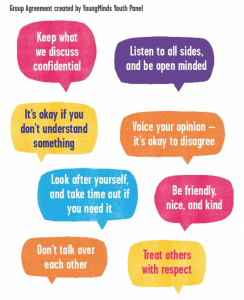
Having a ‘Group Agreement’ such as the one to the right (created by Young Minds Youth Panel) can give direction and expectations whilst also allowing the participants to have an element of ownership over the process if the agreement is created together. This moves the activity to come away from being something done ‘to’ young people into something done ‘with’ them.
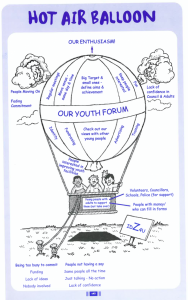
There are similar tools that can stimulate discussion as a group. Templates for these are easy to adapt. The Hot Air Balloon example (featured in Participation: Spice it up! Shepherd, Carol 2002) is one that is commonly used.
This example focuses on what makes a good youth forum: What do you want the group to be? What lifts you up as a group? What pulls you down? What supports you?
The same remit could be used for a range of topics: Our town, our family, our school…
The Covid-19 pandemic brought many challenges for young people, especially in terms of safeguarding, but one of the needs it really exposed was young people’s desire for certainty (in the face of a lack of it).
It’s human nature to want to know what’s happening, when and why. Not knowing can lead to anxiety, paranoia and avoidance. The same is absolutely true when it comes to participation or any interaction with young people. The boundaries and the expectations need to be really clear, to offer that certainty.
If a person burst into the room now and said the following ‘Right, we want you to go to Manchester tomorrow, or possibly Liverpool. OK? Off you go!’ it would be perfectly reasonable if you were to panic and have more questions than answers. Which am I going to? What route will I take? How long will it take? What will I do when I get there? Why am I going? What am I getting out of it? What will happen afterwards? It’s hardly surprising, therefore, that a young person disengages if they’re simply told ‘We’re going to do a participation activity. Let’s go!’
The Welsh Government and ‘Young Wales’ devised National Participation Standards. They work on the basis of what young people will get, and what practitioners will give; essentially a contract.
‘Don’t lie to young people. Don’t say you can do something if you can’t. Just be honest’
Go the next chapter: Chapter 2 – Management Approaches to Support Participation in your Team